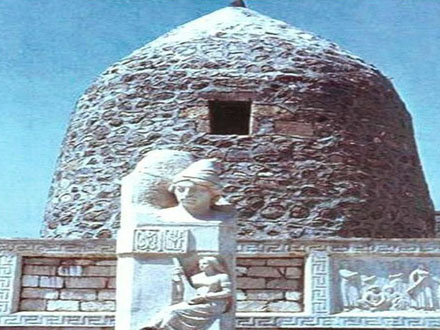Renowned as an adroit master of bayati (a lyrical form of Azerbaijani folk poetry) both in folklore and written literature, Sari Ashuq had become a legend and celebrity in his lifetime, his name and profession had gone through the test of time and reached the present day. In 1927, archaeologists examined Sari Ashuq’s tomb and shrine at the Gulabird cemetery and came to a conclusion that the shrine belonged to the XVII century.
Sari Ashuq hailed from the tribe of Orucmammad which was a big generation in the village of Gulabird. They are natives of Garadag province. They say Sari Ashuq and Orucmammad were both relatives and moved simultaneously to the village of Gulabird. Literary critics classified Sari Ashuq in the history of the world literature not only an adroit master of bayati of the Azerbaijani literature, but also of the whole Turkic world.
In 1989, the memorial museum of the XVII century bayati master Sari Ashuq was opened in the village of Gulabird. At that time, a total of 150 items reminiscent of Sari Ashuq was handed over to the museum. Representatives of the Azerbaijani Union of Writers and the district public attended the opening ceremony of the museum. The surroundings of the museum were beautified and a monument of Sari Ashuq was erected.
After the occupation of Lacin District by the Armenian armed forces, the building of the museum and up to 200 exhibits were destroyed and plundered. Ramiz Qanimatoglu is the director of the museum. At present the museum functions in the settlement of Pirakuskul of Absheron District.
Compiled by Vuqar Tofiqli
Executive director of the Azerbaijan Free Speech Foundation











 Inauguration ceremony of President of Azerbaijan Ilham Aliyev was held
Inauguration ceremony of President of Azerbaijan Ilham Aliyev was held Ilham Aliyev wins presidential election with 92.05 percent of votes VIDEO
Ilham Aliyev wins presidential election with 92.05 percent of votes VIDEO President Ilham Aliyev, First Lady Mehriban Aliyeva and family members voted in Khankendi VIDEO
President Ilham Aliyev, First Lady Mehriban Aliyeva and family members voted in Khankendi VIDEO Plenary session of 6th Summit of Conference on Interaction and Confidence Building Measures in Asia gets underway in Astana. President Ilham Aliyev attends the plenary session VIDEO
Plenary session of 6th Summit of Conference on Interaction and Confidence Building Measures in Asia gets underway in Astana. President Ilham Aliyev attends the plenary session VIDEO President Ilham Aliyev was interviewed by Azerbaijani TV channels in Prague VIDEO
President Ilham Aliyev was interviewed by Azerbaijani TV channels in Prague VIDEO














